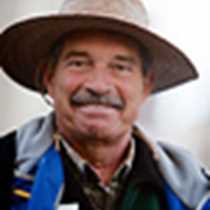Glacier Bay
Early morning found us tied at the dock at Bartlett Cove in Glacier Bay National Park and Preserve, where we picked up our ranger and Native Interpreter for the day. At 6:00 a.m. we left Bartlett Cove and sailed up north, into the huge fjord that was carved and rounded out by the Grand Pacific Glacier. This glacier has advanced and receded various times, but the last recession was in the 1700’s, seen by Vancouver. Today this glacier is believed to be the fastest recorded receding glacier. On we sailed into the northern reaches of the fjord.
As we reached the area around Gloomy Knob, to our amazement we saw, in the first running salmon stream in the park, a wolf fishing for salmon in the shallow waters. It ran back and forth, and came up with a sockeye salmon in its jaws. The season has been bad for bears and definitely for other mammals as well. Berries are few and very late. At the moment we saw this wolf in action, another one appeared from the forest. One of the two was female. The wolves ate more salmon, only eating the heads, especially the brain. At one moment, the animals were gone from our view, and then, to our incredible surprise, we saw a very dark brown bear running from the forest to the beach, being chased by a wolf. The bear reached the stream and then ignored the wolf, and began jumping back and forth in the stream, splashing water everywhere, and immediately coming up with a salmon. It walked a few steps away from the stream, and after a few short bites, had consumed the fish entirely. The wolves showed interest in this fish, approaching the bear within a few feet. The bear mostly ignored them. Again the bear went to water and came up with another big fish. There were many salmon, and they could be seen splashing at the entrance to the stream.
Meanwhile, a group of more than 10 ravens were trying to partake in the bounty. If they approached a feeding wolf, they were immediately rushed at by the big predator, but if the fish was left behind, they would then go up to it and begin feeding. Among them was strife, as dominant ones fought off the lesser ones. And even these fought and kept the glaucous-winged gulls away from the scraps of the fish. All this aggression was interrupted as an adult bald eagle swooped down and dominated the scene by taking over one of the fish bodies.
Back at the ranch, the wolves appeared and reappeared constantly. The bear was not visible for moments, and then would reappear. A third wolf, a young female, approached the feeding bear and patiently waited for scraps, of which there were none. This female urinated near the bear three times! At another moment, one of the wolves caught a fish, and as it was leaving the stream, was rushed by the bear to take the fish, but the wolf managed to escape with the fish in its jaws and the bear returned to the river for more.
We had to leave after about an hour of watching the fantastic behavior between these two species of mammals and the birds, and sailed north to look for more adventure on this marvelous day. If we had visited this stream a month ago, we probably would not have been witnesses to the fantastic action between these animals. It is all tied to food availability, which now, and for the coming month or two, is huge. The stream is about two yards wide, and one cannot help but wonder how many salmon get through that monstrous barrier of hungry animals!
Sailing north, we visited the Johns Hopkins Glacier, one of the few advancing glaciers in Alaska. The 5-mile long fjord leading to this glacier was mostly filled by broken ice, and our slow advance brought us up quite close to its front. To our surprise, we watched a big brown bear, also called a grizzly, walk slowly along the sheer cliffs of the fjord. Off in the distance we could see a number of harbor seals on their preferred ice-flows.




